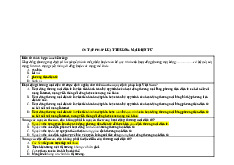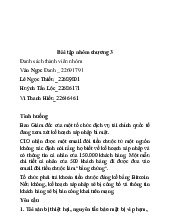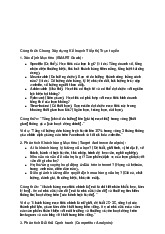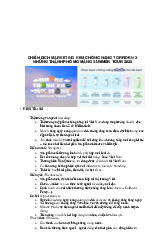



Preview text:
1. The originator of an offer letter is typically the: a. Bank b. Seller c. Delivery service d. Buyer
2. What should the opening of an reactive offer letter typically comprise?
a. A detail history of the seller’s company
b. A demand for immediate payment
c. Thanks for the enquiry and pleasure in offering
d. Critism of the buyer’s requirements
3. In an enquiry letter, you should clearly inform the supplier:
a. Your opinions on market trends
b. Your personal financial status c. Your social media handles
d. What sort of firm you are 4. Please clarify your
, including shipping costs and estimated arrival time. a. Bulk order b. Minimum order quantity c. Lead time d. Delivery terms
5. Which of the following is a key component of an offer letter? a. Irrelevant market gossip b. Buyer’s personal details
c. Complaints about other suppliers
d. Terms and conditions of the sale
6. Which of the following is a common reason for a business to write an enquiry letter? a. To finalize a purchase
b. To advertise their own products
c. To issue a formal complaint
d. To find potential suppliers 7. We are writing this
to request more details about your terms and
conditions for exporting machinery to Vietnam. a. Specification b. Inquiry c. Quotation d. Bulk order
8. When composing the content of commercial correspondence, which of the following might be included? a. Irrelevant opinions
b. Request for information c. Social event invitations d. Personal anecdotes
9. In the fomat of commercial correspondence, the fomal way to address n unknow recipient in the UK is: a. Dear Sir/Madam Smith b. Hi there c. To Whom It May Concern d. Dear Sir/Madam 10. Could you confirm the
of your products? Are they in stock, or do we need to pre-order? a. Quotation b. Minimum c. Availability d. Delivery terms
11. When proposing terms of payment in an enquiry letter, you might mention:
a. Your preferered mode of transportation for personal travel
b. Your personal banking history
c. Usual trade discount expectations d. Irrelevant legal clauses
12. In the structure of commercial correspondence, the opening paragraph of
proactive letter usually states the: a. Recipient’s achievement b. Reason for writing c. Apology for incomvenience d. Writer’s qualifications
13. In an offer letter, making positive remarks about the goods aims to:
a. Provide irrelevant information
b. Discourage the buyer from comparing prices
c. Persuade the prospective customer to do business d. Confuse the buyer
14. Before making a decision, we need to know the exact of your product,
such as size, weight, and material. a. Payment terms b. Inquiry c. Specification d. Availability
15. According to the fomat of an enquiry letter, the sender’s address should be positioned at the: a. Middle of the page b. After the salutation c. Bottom left d. Top left
16. The main aim of an enquiry letter f\rom a buyer is to:
a. Place a firm order for goods
b. Confirm a previous agreement
c. Seek information about a product or service d. Send payment for an order
17. A counter-offer is generally madde by the: a. Buyer of Seller b. Insurance provider c. Delivery company
18. A major benefit of commercial correspondence is its ability to:
a. Gurantee immediate feedback
b. Provide proof of communication
c. Overcome all language barriers d. Ensure absolute privacy 19. Do you have a
for international purchases, or can we order any quantity?
a. Minimum order quantity b. Lead time c. Availability d. Delivery terms
20. Communication in a business setting throught letter exchange is referred to as: a. Interoffice memo b. Personal corresspondence c. Social media communication
d. Commercial corresspondence




